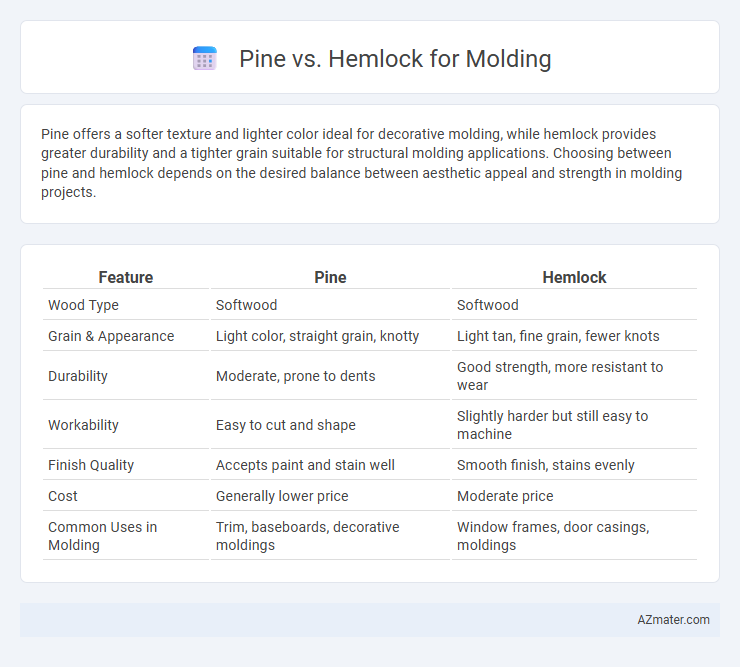Pine offers a softer texture and lighter color ideal for decorative molding, while hemlock provides greater durability and a tighter grain suitable for structural molding applications. Choosing between pine and hemlock depends on the desired balance between aesthetic appeal and strength in molding projects.
Table of Comparison
| Feature | Pine | Hemlock |
|---|---|---|
| Wood Type | Softwood | Softwood |
| Grain & Appearance | Light color, straight grain, knotty | Light tan, fine grain, fewer knots |
| Durability | Moderate, prone to dents | Good strength, more resistant to wear |
| Workability | Easy to cut and shape | Slightly harder but still easy to machine |
| Finish Quality | Accepts paint and stain well | Smooth finish, stains evenly |
| Cost | Generally lower price | Moderate price |
| Common Uses in Molding | Trim, baseboards, decorative moldings | Window frames, door casings, moldings |
Introduction: Comparing Pine and Hemlock for Molding
Pine and Hemlock are popular softwood choices for molding due to their affordability and workability. Pine offers a lighter color with a more pronounced grain pattern, making it ideal for decorative molding that benefits from staining or painting. Hemlock features a straighter grain and finer texture, providing a smooth surface that takes paint well and resists splitting during cutting and installation.
Wood Characteristics: Pine vs Hemlock
Pine features a softer texture with a more pronounced grain pattern, making it easy to carve and ideal for intricate molding designs. Hemlock offers a finer, straighter grain and a denser composition, providing greater durability and a smoother finish for moldings. Both woods are lightweight and resistant to splitting, but Hemlock's rigidity lends a more stable, long-lasting quality to detailed trim work.
Durability and Strength
Hemlock offers moderate durability and strength, making it suitable for interior molding where heavy wear is minimal, while pine, especially Southern Yellow Pine, provides higher density and better resistance to impacts and dents. Pine's greater hardness and structural integrity make it preferable for moldings in high-traffic areas requiring enhanced durability. Both woods accept paints and stains well, but pine's superior strength benefits applications demanding long-lasting performance.
Visual Appeal and Grain Patterns
Pine features a lighter color with a more uniform grain pattern, providing a clean and classic look for molding that suits traditional and rustic designs. Hemlock offers a slightly darker hue with subtle, straight grains and occasional knots, adding natural character and a warm, organic feel to interior trim. The choice between pine and hemlock for molding often depends on desired visual texture, with pine emphasizing brightness and smoothness while hemlock highlights natural variation and depth.
Workability and Ease of Installation
Pine offers superior workability for molding projects due to its softer grain, allowing for easier cutting, shaping, and nailing, which enhances efficiency during installation. Hemlock is denser and harder, making it more challenging to work with but providing increased durability and a smoother finish once installed. For ease of installation, pine's lightweight nature reduces handling effort, while hemlock may require more precise tools and preparation to avoid splitting.
Cost Comparison
Pine molding generally offers a more cost-effective option compared to hemlock due to its widespread availability and faster growth rate, which lowers raw material expenses. Hemlock molding tends to be slightly higher in price because of its superior durability and finer grain, making it favored for premium interior finishes. Choosing pine for molding projects can substantially reduce material costs without sacrificing basic aesthetic appeal, especially in budget-sensitive renovations.
Paint and Stain Performance
Pine exhibits excellent paint adhesion and stain penetration due to its open grain and softwood structure, making it ideal for smooth finishes in molding applications. Hemlock, with its tighter grain and uniform texture, provides a more consistent surface for stain absorption but may require pre-treatment for optimal paint durability. Both woods accept finishes well, but pine's versatility often leads to superior results in both painted and stained molding projects.
Environmental Impact and Sustainability
Pine molding offers a lower environmental impact due to its faster growth rate and higher carbon sequestration compared to hemlock, which grows more slowly and often requires selective logging practices. Sustainable sourcing of pine from responsibly managed forests promotes biodiversity and reduces habitat disruption, while hemlock harvesting can contribute to soil erosion and ecological imbalance if not carefully controlled. Choosing FSC-certified pine molding supports forest regeneration and minimizes carbon footprint, making it a more eco-friendly option in sustainable building projects.
Common Applications in Molding
Pine is widely used in molding for its affordability and ease of customization in interior trim, baseboards, and window casings, making it ideal for residential and light commercial applications. Hemlock offers greater strength and finer grain, preferred for structural moldings and door frames requiring durability and a smooth finish. Both woods are compatible with paints and stains, but pine is more popular in decorative moldings while hemlock suits applications demanding higher load-bearing capacity.
Conclusion: Choosing the Right Wood for Your Molding Project
Pine offers a cost-effective, lightweight option with a smooth grain that accepts paint well, making it ideal for detailed molding projects requiring a clean finish. Hemlock provides greater density and durability with a natural reddish hue that stains beautifully, suitable for molding where added strength and a warm appearance are desired. Selecting between pine and hemlock ultimately depends on balancing budget, desired aesthetics, and the specific structural requirements of your molding project.

Infographic: Pine vs Hemlock for Molding
 azmater.com
azmater.com